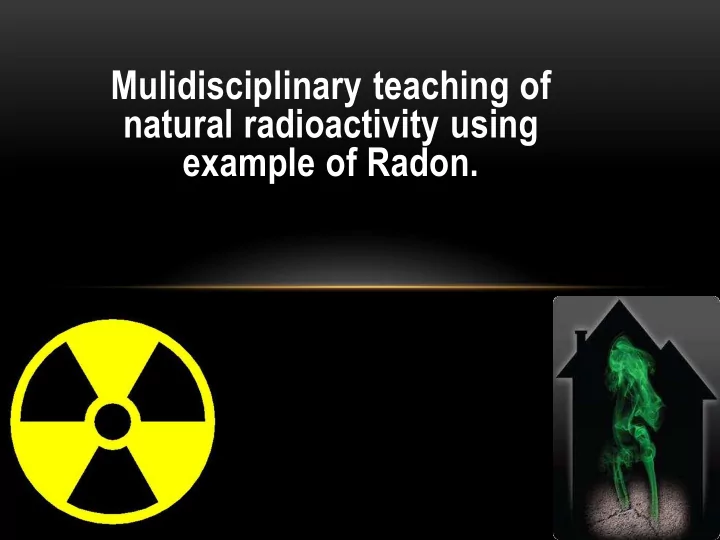

Mulidisciplinary teaching of natural radioactivity using example of Radon.
The task of education is to change the negative attitude toward it.
To teach natural radioactivity module I chose the discussion of the problem of radon as it is related to several scientific fields.
I edited a curriculum in which the scientific subjects can be interconnected by presenting radon. physics geography radon biology chemistry
Where do radioactive materials come from? Where can they be found in the natural environment?
What do we use them for?
What is the proportion of the natural and artificial components like? Az ember által kapott 2,7 mSv - nyi évi effektív dózis megoszlása fő források szerint (mSv) 0,3 Természetes Mesterséges 2,4
atomic energy
We can easily spark the attention of students with the result that in the USA 21.000 people die each year due to radon. Radon is the second leading cause of Lung Cancer, after tobacco smoke.
Discussing the following questions will lead us to the understanding of the problem:
What is radon? It is a chemical element The atomic number 86 and it has the mass number of 220 or 222.
222 Rn , has a half-life of 3.8 days
Where is it situated in the periodic table? And in which group do they belong to? Mendeleev created a table which clearly shows the periodics which can be perceived between elements. Radon is a radioaktiv nobel gas.
The following types of radioactive decay exist :
Radon is produced by alpha decay
Where does radon come from? With this question we introduce the decay chains .
Radon is the alpha decay product of radium which can be found in the soil particles and is also produced by radioactive decay. If we examine the process chain of radioactive decay we arrive to uranium.
The Route of Radon to the Lung
Uranium was formed in a supernova explosion that preceded the formation of the Solar System. Therefore, uranium and radioactivity exist since the formation of the Earth.
As a result of crystallization processes uranium can be found in the asthenosphere.
It surfaced as a result of volcanic eruptions.
From the particles containing uranium radon gets into the cracks of the soil and then, by diffusion , enters into houses.
Radon can enter into the house: along water pipes through cracks in the soil with water
In the airspace radon degrades through alpha decay and it attaches to aerosols in the air. After inhalation this clings to the branches of bronchi and bombs them with alpha particles in a similar mode to the chemical formation of radon.
We measured with students the radon activity concentration of 50 homes. With the help of these results we can make the radon map of Heves county together with students which also improves their mapping and cartographic abilities.
physics chemistry In conclusion, radon is connected to several RADON scientific fields. biology geography
In physics it should address the following topics: 1. The radioactive decay 2. Isotopes 3. Decay chains 4. Detectors
In geography : Supernova explosion • Internal structure of the Earth • Cartography • Stones •
In chemistry: periodic table • noble gases • atoms •
In biology: • The lang • Effects of radon baths in medicine • Biological effects of radiation
The following question the experiment group turned out to be better: • Where do radioactive materials come from and since when they exist? • Where can they be found in the natural environment? • What is the proportion of the natural and artificial components like?
I hope that with the help of the curriculum students will accept that radioactivity is part of nature.
THANK YOU FOR YOUR ATTENTION
Recommend
More recommend